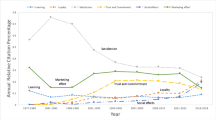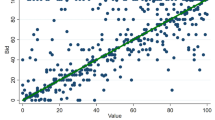Abstract
This paper investigates the time dynamics of user strategic patterns and resulting welfares in a series of overlapping multiple online auctions. An auction mechanism is a dynamic game where the valuation and strategic space of bidders determine the outcomes. When those mechanisms exist concurrently or in a series in a market environment, multiple sources are visible and accessible, such that there is likely to be a form of interdependency across the auctions. While heterogeneous bidder behavior has been studied in some literature, the focus is mainly on an individual auction level and the underlying dynamics regarding the interdependency across the auctions in the market has not been explained. We use a two-phased approach to address this discrepancy. First, we classify user strategy using k-means clustering. Then, we characterize the transition pattern of heterogeneous clusters using a dynamic systems framework. Long-term behavior of the system is effectively and efficiently predicted using system parameters. The empirically calibrated simulation, which supports the analytical properties, provides managerial insights in designing multiple overlapping online auction market.











Similar content being viewed by others
Notes
As of 2009, Sam’s Club uses the same price progress, winner determination rules and bidding procedure.
In this mechanism level analysis, each bidder in each auction is counted individually.
Dissimilarity ratio is inter-cluster distance (the minimum distance among the different clusters) divided by intra-cluster distance (average distance between each data point and the cluster center). We selected the k that yields the highest dissimilarity ratio.
References
Anwar, S., McMillan, R., & Zheng, M. (2006). Bidding behavior in competing auctions: evidence from eBay. European Economic Review, 50(2), 307–322.
Ashenfelter, O. (1989). How auctions work for wine and art. The Journal of Economic Perspectives, 3(3), 23–36.
Bajari, P., & Hortacsu, A. (2003). The winner’s curse, reserve prices, and endogenous entry: empirical insights from eBay auctions. The Rand Journal of Economics, 34(2), 329–355.
Bapna, R., Goes, P., & Gupta, A. (2001). Online auctions: insights and analysis. Communications of the ACM, 44(11), 42–50.
Bapna, R., Goes, P., & Gupta, A. (2003). Replicating online Yankee auctions to analyze auctioneers’ and bidders’ strategies. Information Systems Research, 14(3), 244–268.
Bapna, R., Goes, P., Gupta, A., & Jin, Y. (2004). User heterogeneity and its impact on electronic auction market design: an empirical exploration. MIS Quarterly, 28(1), 21–43.
Bapna, R., Chang, S. A., Goes, P., & Gupta, A. (2009). Overlapping online auctions: empirical characterization of bidder strategies and auction prices. MIS Quarterly, 33(4), 763–783.
Easley, R. F., & Tenorio, R. (2004). Jump bidding strategies in internet auctions. Management Science, 50(10), 1407–1419.
Engelbrecht-Wiggans, R. (1987). On optimal reservation prices in auctions. Management Science, 33(6), 763–770.
Engelbrecht-Wiggans, R., & Weber, R. J. (1979). An example of a multi-object auction game. Management Science, 25(12), 1272.
Engelbrecht-Wiggans, R., & Kahn, C. M. (1999). Calibration of a model of declining prices in cattle auctions. Quarterly Review of Economics and Finance, 9(1), 113.
Goes, P., Karuga, G., & Tripathi, A. (2009). Understanding willingness-to-pay formation of repeat bidders in sequential online auctions. Information Systems Research, published online before print May.
Levin, D., & Smith, J. L. (1994). Equilibrium in auctions with entry. The American Economic Review, 84(3), 585–599.
Luenberger, D. G. (1979). Introduction to dynamic systems: Theory, models, and applications. John Wiley & Sons.
Mcafee, R. P. (1993). Mechanism design by competing sellers. Econometrica, 61(6), 1281–1312.
McAfee, R. P., & Vincent, D. (1993). The declining price anomaly. Journal of Economic Theory, 60(1), 191–212.
Milgrom, P. (1989). Auctions and bidding: a primer. The Journal of Economic Perspectives, 3(3), 3–22.
Peters, M., & Severinov, S. (2006). Internet auctions with many traders. Journal of Economic Theory, 127(1), 220–245.
Peters, M., & Severinov, S. (1997). Competition among sellers who offer auctions instead of prices. Journal of Economic Theory, 75(1), 141.
Pinker, E., Seidmann, A., & Vakrat, Y. (2010). Using bid data for the management of sequential, multi-unit, online auctions with uniformly distributed bidder valuations. European Journal of Operational Research, 202(2), 574–583.
Reinartz, W. J., & Kumar, V. (2000). On the profitability of long-life customers in a noncontractual setting: an empirical investigation and implications for marketing. Journal of Marketing, 64(4), 17–35.
Steinberg, R., & Slavova, M. (2005). Empirical investigation of multidimensional types in Yankee auctions. Cambridge University, working paper.
Vickrey, W. (1961). Counterspeculations, auctions, and competitive sealed tenders. Journal of Finance, 16, 8–37.
Zeithammer, R. (2006). Forward-looking bidding in online auctions. Journal of Marketing Research, 43(3), 462–476.
Author information
Authors and Affiliations
Corresponding author
Rights and permissions
About this article
Cite this article
Chang, S.A. Time dynamics of overlapping e-auction mechanisms: Information transfer, strategic user behavior and auction revenue. Inf Syst Front 14, 331–342 (2012). https://doi.org/10.1007/s10796-010-9249-x
Published:
Issue Date:
DOI: https://doi.org/10.1007/s10796-010-9249-x




